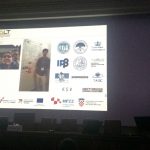Dr. sc. M. Kralj held a keynote lecture on Photonica 2017
 Marko Kralj held a keynote lecture “In situ visual observation of 2D materials growth and modifications, and characterization of their optical properties” on Photonica 2017 in Belgrade.
Marko Kralj held a keynote lecture “In situ visual observation of 2D materials growth and modifications, and characterization of their optical properties” on Photonica 2017 in Belgrade.
In order to demonstrate possibilities of the nano-scale control of 2D materials, first we investigate epitaxial graphene on iridium. This system exhibits intrinsic properties matching that of a freestanding graphene but the presence of a metal substrate in this case introduces superperiodic potential to graphene [1]. We use scanning tunneling microscopy (STM), low energy electron microscopy (LEEM) and electron spectroscopy to study a mechanism and effects of insertion/intercalation of atomic layers between graphene and iridium [2]. Along with a pronounced charge transfer effects, a quasiparticle scattering of doped graphene is directly visualized in low-temperature STM, marking a pseudospin character of electrons in graphene [3]. Furthermore, we demonstrate a way to extend optoelectronic applications of graphene and bypass limited use of graphene in plamonics only in the mid-infrared range. In the highly doped epitaxial graphene we report a novel optical response of graphene plasmons in visible, showing a strong nonlinear response on a femtosecond time scale as well as THz oscillation of resonance energy [4].
Next, we show how optical visibility of mono- and few-layer TMDs samples on SiO2 covered silicon wafers at elevated temperatures was exploited to construct chemical vapor deposition system with optical access for real time microscopy that enables observation of TMDs during growth. This provides us a significant level of control and understanding of the growth process, which is crucial for development of TMD materials for large-scale applications [5]. After synthesis, the quality of grown MoS2 and WS2 samples and their heterostructures is checked by the characterization of optical response, transport and in particular STM characterization of atomic-scale defects and their typical concentrations at the nano-scale [6]. Finally, we show how macromolecular adsorption strongly enhances photoluminescence response of single layer MoS2 [7], paving a way for development of sensing applications of TMSs.
REFERENCES
[1] I. Pletikosić, M. Kralj, P. Pervan, et al., Phys. Rev. Lett. 102, 056808 (2009).
[2] M. Petrović, I. Šrut Rakić, S. Runte, et al., Nat. Commun. 4, 2772 (2013).
[3] D. Dombrowski, W. Jolie, M. Petrović, et al., Phys. Rev. Lett. 118, 116401 (2017). [4] S. Tanaka, M. Petrović, K. Watanabe, et al., submitted (2017).
[5] D. Čapeta, I Šrut Rakić, M. Kralj, et al., in preparation (2017).
[6] I. Delač Marion, D. Čapeta, B. Pielić, et al., in preparation (2017).
[7] I. Delač Marion, N. Vujučić, D. Čapeta, et al., in preparation (2017).